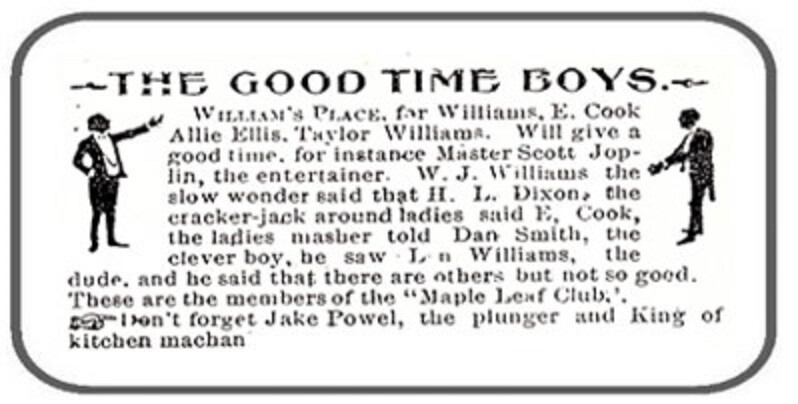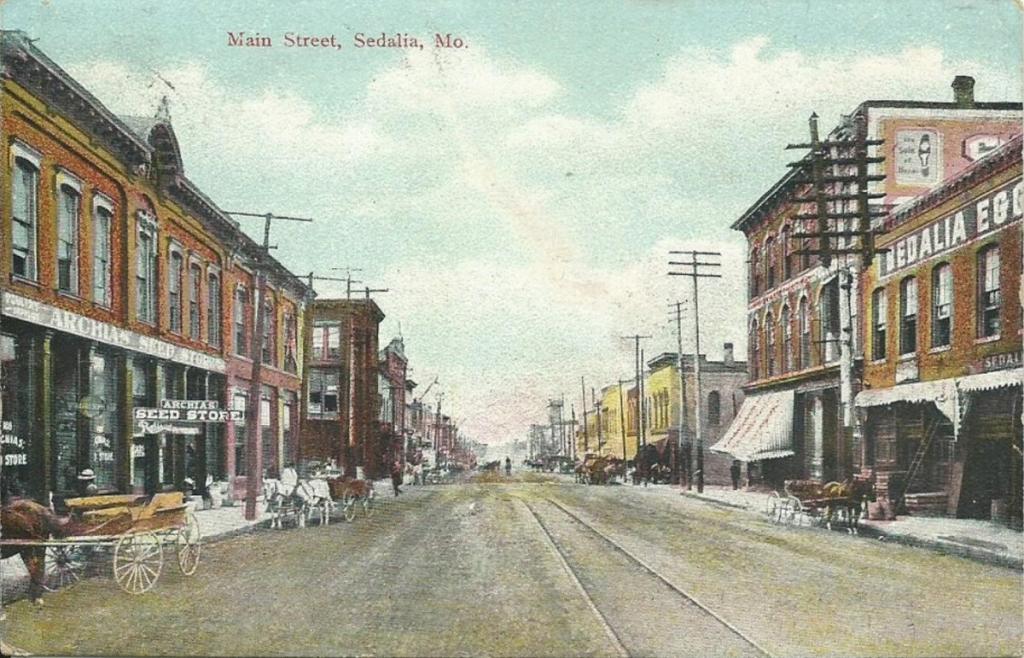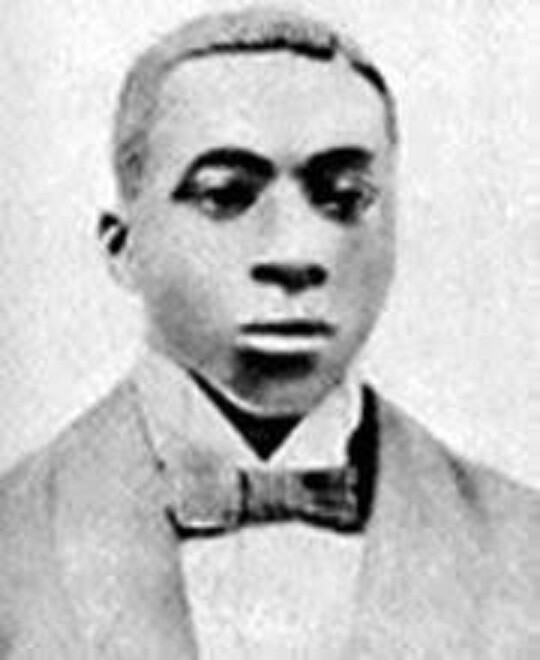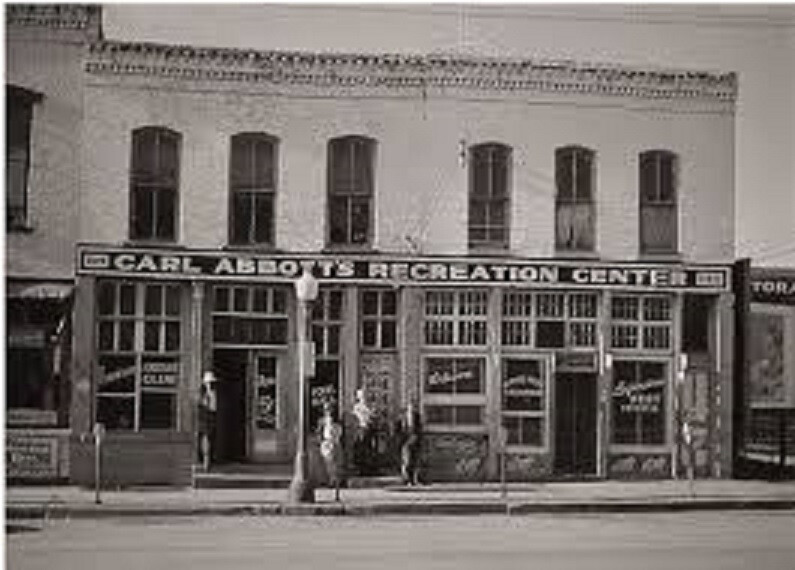Last month I began my comment on the confusing heritage of Sedalia’s Maple Leaf Club (MLC). Was it the benign men’s social club of the group’s incorporation papers or a bawdy “gentlemen’s” sporting club of the city’s Main Street “Battle Row?” Here are the major Sedalia newspaper accounts of the club in the ragtime era.
 Before the club’s formal incorporation in December of 1898, a sampling of the men mentioned on the MLC card found them frequently in the news. Tony William was known for his cakewalking prowess in the many events he sponsored or in which he participated in communities around Sedalia. H.L. Dixon and Jake Powell were also often contestants and Dixon and Williams were often winners.
Before the club’s formal incorporation in December of 1898, a sampling of the men mentioned on the MLC card found them frequently in the news. Tony William was known for his cakewalking prowess in the many events he sponsored or in which he participated in communities around Sedalia. H.L. Dixon and Jake Powell were also often contestants and Dixon and Williams were often winners.
However, Jake Powell seems to have spent some time annually in jail serving time in the 1890s for everything from disturbing the peace to assault, fighting, and visiting a bawdy house with charges against him escalating through the decade. Allie Ellis was caught up in one night of arrests with Powell. Dan Smith and Len and John Williams seemed to be occupied as members of various singing quartets making the papers. Only Powell seems to have been habitually arrested and at times for serious offenses.
Thus, at least some of the members of the Maple Leaf Club had varied experiences with the law while others were involved in respectable activities.
Just prior to the filing of incorporation papers, The Maple Leaf Club as first named in the newspapers and was reported having a ball and banquet on Thanksgiving night 1898 and on Dec. 8th a masked ball to benefit the Queen City Cornet band was held. The two East Main Street Clubs are often mentioned together in new reports.
After the Club was officially incorporated the first event of note in 1899 was a cake walk on Jan 13th which was to be repeated February 15th apparently as a monthly affair. The winners were not charter members. On January 20th, the Maple Leaf Club held a Buck and Wing dancing exhibition featuring Jake Powell and Ernest Fleming which had to be repeated the following evening to decide a winner.
However, a series of newspapers articles beginning with the Sedalia Democrat on January 17 report a petition signed by the colored ministers of the city requesting that the Club along with the Black 400 Club (BFC) across the street be closed referring to them as, “abominable loafing places…hot beds of immorality.”
C.E. Williams, identified as president of the Maple Leaf Club refuted the ministers’ claim and remarked that “at two dress balls, 40 of the best white people of Sedalia (were) in attendance as spectators.” The same day the Sedalia Sentinel headlined, “There is a shadow on the future of the BFC and MLC.” The week before the clubs had to be closed one night within a month of the MLC incorporation and “admonished to do better or fare worse.”
In a supposed effort to regain its reputation, an “entertainment for the benefit of the poor colored people of the city,” was presented on February 16th.
On March 16th, the first of a series of prize fights, this one “red hot” but without arrests, was recorded at the MLC. A week later a republican meeting was held in the MLC rooms to support Dr. Crawford for mayor and apparently the two kegs of beer at the gathering “was noticeable on the street.” This was contrasted by a reference to the “large, intelligent and sober gathering of democrats at McGinley’s Hall.”
A mixed-race crowd at the MLC on May 22nd witnessed a prize fight between black and white fighters. On June 2nd, the MLC had to be closed for staying open too late.
Black Diamond billed as “Monster Mouth” was advertised for an MLC event in mid-June. He seems to have been mimicking Billy Kersands the popular minstrel comedian of the day. In July, the Maple Leaf Club baseball team was beaten by a score of 28 to 10. The effort for legitimacy, took its losses, too.

I insert here to remind readers that the famous “Maple Leaf Rag” contract between John S. Stark and Scott Joplin was signed on August 10th at Stark’s business, 114 E. 4th in 1899. A serious fire in the Knights of Pythias Building in September where Stark’s business was located, destroyed most of the first Sedalia printing of the Maple Leaf Rag.
Perhaps the most noteworthy event to tarnish the MLC came on October 1st when a fight over a girl in the rooms spilled over into the street. Arthur Marshall who would have been 18 at the time struck at E. S. Edwards with a loaded cane and Edwards “took a shot at Marshall but without effect.” The result was Edwards’ arrest for discharging a firearm in the city.
The Club was raided on October 22 by the entire night police force including the chief and a great deal of illegal liquor was seized. Apparently, a number of “young society people” (probably indicating whites) were at the event and surprised to find their names in the paper. According to the Sentinel, a line of sullen black and white men and women sat silently along the seats on prisoners’ row.
In December, the president of the Autumn Leaf Club wanted it to be known in the paper that he did not lead the MLC as the paper must have miss reported. Just before Christmas, “one of the bloodiest (fights) ever witnessed,” occurred in the MLC rooms. The fight was among women with knives who held old grudges. One woman however was “in bad condition.”
Finally, on Christmas day night a woman who had just left the MLC apparently committed suicide by strychnine thus ending the MLC’s first year with a mixed, but hazy record.

The centennial year began with a series of forced closings through January of both the MLC and the BFC. Often the city’s intent was to keep them closed but within days they were usually open again. The charges against the groups usually involved women fighting (finish fights,) or illegal liquor sales. The January closing was precipitated by arrests made after the MLC raided the BFC on January 14th when the police found a “merry war going on,” William Hubbard accidentally shot his wife and a police officer was attacked with a knife. Hubbard, an MLC charter member was tried in State court for his crime. On January 30th, some members tried to open the Club but merely had to assemble on the street.
By March, the Club was open and a prize fight featuring “Black Diamond,” was held. Diamond may have won by an illegal blow possibly softened in the newspaper to read “a blow in the solar plexus.”
Disturbance of the peace calls were frequent and the ones involving women as on April 1st pointed out a violation of the MLC corporation statement. On two nights at the end of May, the Club hosted six and seven round prize fights. By June, another closing petition was presented to the City but this one was quickly protested as a fraud. Several including Tom Ireland declared his signature had been forged. Nevertheless, the clubs were briefly closed. A few days later a group was found in the Club rooms but when police arrived, they had escaped through an open second story window.
Finally, on June 24, Mayor Crawford met with leaders of both clubs and both agreed to close their doors on June 31.
On June 27, Joplin and Henry Jackson presented a musical in Forest Park on the South Edge of the city. It was a success and is a reminder that Joplin and the other Sedalia composers were still in Sedalia. On July 23, Stark presented copies of the “Maple Leaf Rag” and “Swipsey: a Cake Walk” to the Sedalia Democrat newspaper. However, things turned violent again at the MLC in July when another knife fight occurred, but no one was hurt. The clubs had promised to shut down the end of June. Another fight described as a riot, broke out at the Club on 18 August.
The incorporated groups were supposed to end by July 1900 or thereabout. However, the MLC continued to appear in the newspapers well into 1902, nearly always for fights or disturbances. Rufus Hawkins was arrested in Sedalia for a murder in St. Louis in 1902 and also accused of being involved in nearly every MLC fight of 1901.
Probably in November of 1902, Tom Ireland recalled having taken W.C. Handy to the Club rooms at the composer’s request and he heard the house band that Joplin had organized, play the “Maple Leaf Rag,” “Swipsey,” and “Sunflower Slow Drag.” So, it seems in spite of its negative reputation it has always been considered a place Joplin made famous.
Charles Hanna, Sedalia Capitol editor in the late 1940s, wrote in his memoir Searching for the Sea, that he would go to the old Club rooms and sit in with the band. Tom Ireland even came to listen one time to see “what a White boy wuz gonna do with that licorice stick.”

It is also a fact that up until the Abbott Recreation Parlor was leveled in 1958, 121 E. Main was known as the place where once the Maple Leaf Club gathered.
I always thought when I first read the clippings regarding the city’s decision to demolish the building for a parking lot, that it was racially motivated. However, I came to realize to many in the black and white communities, it was a reminder of the immorality and fights and disturbances of the old “Battle Row,” and it was often used to indict the entire North Side. To those in the ragtime community it is a place of honor because Joplin and his composer friends worked there and began creating Classic Ragtime.
So, there were never two Maple Leaf Clubs but rather two distinctly different reputations of the same group. This is so typical of the duality of the Ragtime Era.
Larry Melton was a founder of the Scott Joplin Ragtime Festival in 1974 and the Sedalia Ragtime Archive in 1976. He was a Sedalia Chamber of Commerce manager before moving on to Union, Missouri where he is currently helping to conserve the Ragtime collection of the Sedalia Heritage Foundation. Write him at lcmelton67@gmail.com.






















